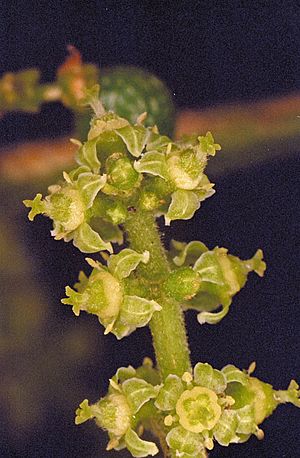Melicope xanthoxyloides facts for kids
Quick facts for kids Yellow evodia |
|
|---|---|
 |
|
| Melicope xanthoxyloides male flowers | |
 |
|
| Female flowers | |
| Scientific classification | |
| Genus: |
Melicope
|
| Species: |
xanthoxyloides
|
| Synonyms | |
|
|
Melicope xanthoxyloides is a small tree often called Yellow Evodia. It belongs to the Rutaceae family, which also includes citrus fruits. This tree is naturally found in New Guinea and Queensland, Australia. It's known for its leaves, which have three leaflets, and its small, greenish-yellow flowers that grow in clusters.
Contents
What Does Yellow Evodia Look Like?
Yellow Evodia is a tree that usually grows up to 21 meters (about 69 feet) tall. Its trunk is typically no wider than 30 centimeters (about 12 inches).
Its leaves grow in pairs opposite each other. Each leaf has three smaller leaflets attached to a stalk called a petiole, which can be 35 to 140 millimeters long. The leaflets themselves are usually 110 to 270 millimeters long and 50 to 125 millimeters wide. They are shaped like an ellipse or an egg, with the narrower end at the base.
The flowers are small and can be green, yellow, or cream-colored. They grow in clusters called panicles, which are 50 to 140 millimeters long. These clusters appear where the leaves meet the stem. Interestingly, male flowers and female flowers grow on separate plants.
Each flower has four small, egg-shaped sepals that are about 0.5 millimeters long and joined at their base. The petals are 1.3 to 2 millimeters long. Male flowers have four stamens, which are the parts that produce pollen.
Yellow Evodia usually flowers from November to April. After flowering, the female plants produce fruit. The fruit is made up of up to four small pods called follicles, each 3 to 4 millimeters long and joined at the base.
How Yellow Evodia Got Its Name
The Yellow Evodia was first officially described in 1864 by a botanist named Ferdinand von Mueller. He gave it the name Euodia xanthoxyloides. He published his description in a book called Fragmenta phytographiae Australiae. He studied plant samples collected near Rockingham Bay by John Dallachy.
Later, in 2001, another botanist named Thomas Gordon Hartley changed its name to Melicope xanthoxyloides. This new name was published in a science journal called Allertonia.
Where Does Yellow Evodia Grow?
Yellow Evodia grows naturally in rainforests. You can find it from areas near the sea all the way up to altitudes of 1,100 meters (about 3,600 feet).
It is found in New Guinea, including the Bismarck Archipelago. In Australia, it grows from the McIlwraith Range on Cape York Peninsula down to the Herbert River in northern Queensland.
Is Yellow Evodia Safe?
The Queensland Government in Australia has a law called the Nature Conservation Act 1992. Under this law, the Yellow Evodia is classified as a species of "least concern." This means that it is not currently considered to be at risk of disappearing.

